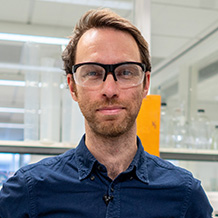Dr Christopher Spicer
Lecturer in Chemistry
Research
When we suffer from injury or disease, we depend on the ability of our body to repair itself and regenerate damaged tissue. Nature relies on complex and dynamic networks of biochemical signals to control this healing process. As a chemist, I’m interested in how we can understand and take inspiration from these natural systems, to develop exciting new technologies able to instigate, enhance, and accelerate healing. By designing synthetic biomolecules and materials which can modulate and mimic biology, we can generate innovative strategies to treat some of the most prevalent illnesses and diseases worldwide.
Recreating the complexity and biological signalling of native environments offers exciting challenges in chemical biology and materials chemistry. My group’s research focuses on developing new strategies for attaching bioactive peptides and proteins to 3D scaffolds that overcome the limitations of current biomaterial design approaches. To do this, we combine cutting-edge tools in biomaterial conjugation, dynamic chemistry, and bio-functionalisation to harness the power of native regenerative environments. This approach allows us to generate modular platforms for controlling cellular growth and behaviour, and to drive the growth of functional and mature tissue.
Biography
Chris joined the University of York as a Lecturer in Chemistry in 2018. Previously, he studied Natural Sciences at the University of Cambridge, graduating with an MSc in 2009. He moved to the University of Oxford later that year and undertook his PhD with Prof. Ben Davis, where he studied new metal-mediated reactions for protein modification. In 2013, Chris joined the group of Prof. Molly Stevens for postdoctoral research, first at Imperial College London and then the Karolinska Institutet in Stockholm. His research focused on the design and synthesis of materials for tissue engineering and biosensing.
Projects
Interested Masters and PhD students are encouraged to contact Chris (chris.spicer@york.ac.uk) for further information about available projects.
Publications
Selected Publications
'Selectivity and stability of N-terminal targeting protein modification chemistries'
L. J. Barber, N. D. J. Yates, M. A. Fascione, A. Parkin, G. R. Hemsworth, P. G. Genever, *C. D. Spicer; RSC Chem. Biol., 2023, 4, 56-64.
'Insight into ortho-boronoaldehyde conjugation via a FRET-based reporter assay'
N. C. Rose, A. V. Sanchez, E. F. Tipple, J. M. Lynam, *C. D. Spicer; Chem. Sci., 2023, 4, 56-64.
'Synthesis of Phospho-Amino Acid Analogues as Tissue Adhesive Cement Additives'
*C. D. Spicer, M. Pujari-Palmer. H. Autefage, G. Insley, P. Procter, H. Engqvist, M. M. Stevens; ACS. Cent. Sci., 2020, 6, 226-231.
'Hydrogel scaffolds for tissue engineering: the importance of polymer choice'
*C. D. Spicer; Polym. Chem., 2020, 11, 184-219.
'Palladium-mediated enzyme activation suggests multiphase initiation of glycogenesis'
M. K. Bilyard, H. J. Bailey, L. Raich, M. A. Gafitescu, T. Machida, J. Iglésias-Fernández, S. S. Lee, C. D. Spicer, C. Rovira, W. W. Yue, B. G. Davis; Nature, 2018, 563, 235-240
'Achieving Controlled Biomolecule-Biomaterial Conjugation'
*C. D. Spicer, E. T. Pashuck, M. M. Stevens; Chem. Rev., 2018, 118, 7702-7743
‘Peptide and protein nanoparticle conjugates: versatile platforms for biomedical applications’
*C. D. Spicer, C. Jumeaux, B. Gupta, M. M. Stevens; Chem. Soc. Rev., 2018, 47, 3574-3620.
‘Synthesis of hetero-bifunctional, end-capped oligo-EDOTs for tissue engineering applications’
C. D. Spicer, M. A. Booth, D. Mawad, A. Armgarth, C. B. Nielsen M. M. Stevens; Chem, 2017, 2, 125-138.
‘Selective chemical protein modification’
C. D. Spicer, B. G. Davis; Nat. Commun., 2014, 5, 4740.
C. D. Spicer, T. Triemer, B. G. Davis; J. Am. Chem. Soc., 2012, 134, 800-803.

Contact details
https://www.spicerlab.com/
